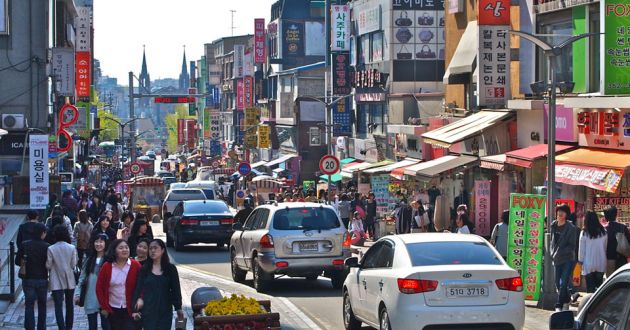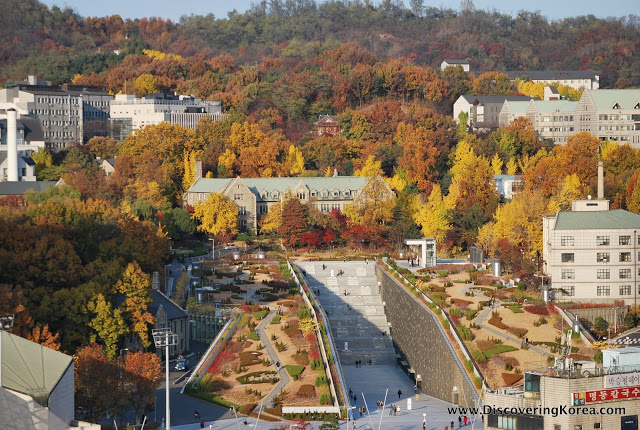Periodically, we explore places to see in the big city. This time around we’ll head to a vibrant neighborhood that’s often overlooked on Seoul itineraries.

That neighborhood is Edae (이대), which along with the neighborhoods of Sinchon (신촌) and Hongdae (홍대), are perhaps Seoul’s most famous areas for college students.
Sure, Sinchon and Hongdae are very well-known for their youthful exuberance, but Edae has its own distinct character and youth culture that shouldn’t be missed.
Located on a patch of western Seoul anchored by Ewha Womans (sic) University (이화여대학교), the sprawling campus is a funky grid of narrow, car-unfriendly alleys packed with cheap hole-in-the-wall restaurants, clothing boutiques and other businesses popular among young women.

These include cafés, cosmetics stores, and beauty salons that advertise their connection to former Miss Korea’s. Walk east and you’ll pass over 100 wedding boutiques, although you might be surprised to learn that the school didn’t allow married women to enroll until 2003.
Like its customers, Edae prefers to wake up late and stay up late.
Each morning, when a steady line of women walk the half-kilometer from the Edae Station (이대역) towards campus, most of the shops on what’s been dubbed “fashion street” are still shuttered.
But on the weekends, shops stay open past 11 pm and the alleys are packed tightly with young couples and packs of mostly female shoppers who shop while munching on street meat.

But, like everywhere else in this city it seems, Edae is undergoing significant changes. Just 2 years ago, several dozen 1 to 4 story buildings stood where a huge Yes Apm department store/residential tower does today.
More consolidation is inevitably on the way.
But the neighborhood’s namesake has also undergone big physical changes. Founded 120 years ago by Methodist missionaries, Ewha Womans University is the world’s largest university for women.
The name “Ewha” means “pear blossom” and was bestowed by Korea’s Emperor Gojong. The campus’ 74 buildings are considered by many to be Korea’s most beautiful college.
For several years, the distinguished campus endured heavy construction, but now Ewha students are enjoying the Ewha Campus Center (ECC), an ambitious 3-year, 100-billion won ($102 million) project designed by Paris-based architect, Dominique Perrault.

The 66,000 square meter, modern 5-level structure is mostly underground, but a 25-meter-wide, 250-meter-long “campus valley” cuts through the center of the gently sloping hillside.
The valley floor is granite and two high walls of steel and glass lead you towards a long granite staircase. The structure’s roof is covered in trees, shrubs, a lawn, and a patchwork path made of jagged stones.
Opened in 2008, the airy and impressive ECC contains a library, cafeteria, fitness center, 40 seminar rooms, parking, administrative and sleeping rooms, as well as a 774-seat performance theater.
Formerly the site of Ewha Square and an athletic field, the center is the university’s largest open space and its primary link with the surrounding neighborhood.
According to one description, “it establish[es] organic relations between the center and surrounding areas of campus as well as between above ground and underground spaces.”

Given the poor design or execution of many projects of this kind and scale, I’d say the outcome is quite impressive.
But if shopping and old-meets-new architecture aren’t your things, Edae may still be your place. If you keep walking up the forested hill behind the university, you’ll find panoramic views of Seoul.
Keep walking and you’ll find Bongwonsa (봉원사), a beautiful Buddhist temple. If that still doesn’t impress you, hop on a train and go somewhere else at the conveniently located Sinchon Train Station.
For Your Information..
| Open: | 24 hrs |
| Admission Price: | N/A |
| Address: | Seoul Seodaemun-gu Daehyeon-dong |
| Directions: | Ewha Woman’s University Station (#241) on Line 2, Exit 2~3 |
About Matt Kelley
Matt Kelly is native of the US Pacific Northwest and is half-Korean by ethnicity. He lived in Korea for five years and has written hundreds of travel guides for Wallpaper, TimeOut, the Boston Globe and Seoul Magazine and was a host for several different variety shows on Korean radio and television.
